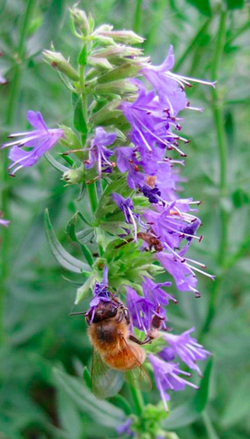
Hyssop (Hyssopus officinalis) is an evergreen perennial herb. It is much beloved by bees and butterflies when flowering, and has a lovely aroma.
Description[edit | edit source]
The leaves of hyssop are slender and medium to bright green. The leaves have a pleasing aroma. The leaves remain present throughout winter.
The flowers are a rich blue, violet colour, present during late summer and into autumn (fall). Some varieties of hyssop have white and pink flowers.
The plant grows between 30 to 60cm (1 to 2 feet) in height.
Rock hyssop (Hyssopus aristatus) has sapphire blue flowers. It grows to about 30cm (1 foot). It is good for edging.
Growing hyssop[edit | edit source]
Choose a sunny position. Hyssop can also tolerate partial shade.
The soil should drain well.
Sow seed in open ground about 6mm (1/4 inch) deep. Alternatively, sow in seed trays and transfer the seedlings when ready.
If using cuttings: Choose cuttings of about 5cm (2 inches) in length, from summer growth. Choose cuttings without flowers. Dip in some rooting hormone and plant in a container.
Tending to hyssop[edit | edit source]
Hard prune hyssop in spring to keep it neat and with a defined edge.
Uses for hyssop[edit | edit source]
The principal use for hyssop is ornamental and as an insect attractant. The flowers can be used as decoration in a dainty floral arrangement.
Tea can be made from the flowers and young leaves.
Flowering tops and young leaves can be added to salads and vegetable dishes, provided you like the mint-like, bitter flavour.